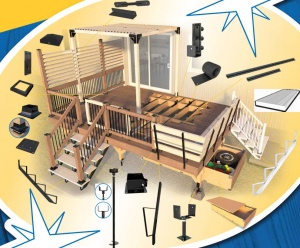Helical Pier Foundation
Jump to navigation
Jump to search
Intro
Helical piers are essentially augers stuck into the ground, which serve as a foundation.
Industry Standards
See Open Source Helical Piers Industry Standards.
Basic Calculations
Take a 3" helical pier that can hold 12,000 lb/sf on rock or 1500 lb/sf on soft clay, with a safety factor of 2 [1].
- 7000 ft lb torque for screwing 8" diameter helix in [2]
- note that if the pier has 2 helices, that doubles the load bearing capacity! You can stack the helices, but need enough space between the helices.
- Helix is .217" pipe, 3" diameter. Steel Weight Calculator sez it's 6.5 lb/ft. Nice! Helix can be 3D printed with WAAM at $1/lb.
- Thus, the piers are quite affordable. The helix and couplers will be the hard part, that's where WAAM comes in.
Square
- 1.25" square piling is 20 kip according to Hubbell [3]. Cold rolled steel is $14/ft at this size. [4]
Round
- Industry standard for 50 kip in soft soil is 2.5" HSS schudule 40 steel, hot dip galvanized. [5]. Cost at Metal By the Foot for black pipe of same size is $8/ft. [6]
First Principle Calculations
Cost
- 2" galvanized pipe - $4/ft - at 3.65 lb/ft - [7]. That plus a 3/8" plate at 15 lb/sf.
- This article says $150-250 per house pile - [8]
- Average cost of a 20' helical pile - - around $700-1400. [9]
- $400-2000 per pile - [10]
- $1000-1400 per 20' pile - [11]. 5-7' pile sections with double 10&12" helix are $100-150, and extensions are 70-90.
- Helical pile, not "coil." On face value, the cost of the concrete and tube are minimal and are way cheaper than any helical pile. But when you factor in the time to excavate, cost to relocate spoils and/or backfill, time to wait for an inspection, time to place the concrete, time waiting for concrete to cure, and the fact that you have no idea if the soil you just placed those Sonotubes in is actually capable of bearing the load, helical piles win every time. Prices for installed helical piles start at around $150 per pile and get more expensive commensurate with the loading requirements. —Greg Di, Bergen County, N.J. - [12]
- The smallest Techno Metal Post, P1, can handle up to a 6,800-pound load, which is more than double what that 14-inch Sonotube is estimated to take. Each dealer sets their own pricing, but it's probably around $150, give or take … [The] P2 is the most commonly used residential pile and it can handle 9,600 pounds. You would need a 24-inch Sonotube in at least 3,000 [psf] soil to get that loading conventionally. —Greg Di - ibid.
- It is difficult to get a man to understand something, when his salary depends on his not understanding it. - Upton Sinclair - ibid.
- Tiny House guy Tristan Perry, $200-800 per pile installed - [13]
Specifications
- Example of pile hardware specs - [14]
Examples
Sourcing
- $42 at Home Depot - [15]. Powder coated. See their product catalog of interesting products - [16] (click to expand):
Technique
- Manual drive with 2x4 using a rebar straightness starter - see video there - [17]
Drive Heads
Suppliers
- Spreadsheet of suppliers - Helical Pier Suppliers
- https://paalupiste.com/ - Europe manufacturer
- Piertech -
 - good detail of all steps.
- good detail of all steps.
How it Works
- [18]. OSE's Universal rotor is 1,250 ft lb torque - so 3x geardown is sufficient for small home foundations.
- https://magnumpiering.com/product-category/literature-and-resources/install-resources/ - technical resources
- Around p. 180 you get shaft sizes and bearing capacities - [19]
- Design Guide, from Hubbell - [20]. Specifications for the CHANCE piles - [21]. Online design software - [22]
Machine Design
- 1 lb pile driving machine weight per 1 lb drive torque - [23]
Making Helical Piles
Links
- Background work on advantages - Helical Piers
- Main work - Helical Pier Foundations
- Helical Pier Suppliers
- Helical Pier Fabrication
- Other - Pier Foundation
